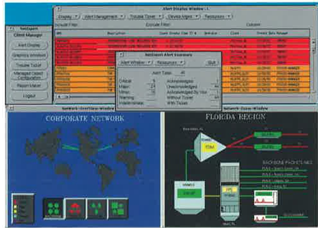Objective Systems Integrators (OSI) of Folsom, California, is a leading provider of network-based operation support systems (OSS) software to commercial enterprises and the telecommunications indust1y. OSI’s customer roster includes major telecommunications companies in the U.S. and Europe, as well as Canada’s nine major telephone companies operating as the Stentor Alliance. Currently, most of these companies use NetExpert™, OSI’s premier product, to manage their wide-area networks (WANs).
NetExpert offers broad functionality through features such as expert systems and object-oriented development. Embedded within NetExpert (and critical to its ease-of use) is SL Corporation’s SL-GMS. SL-GMS software is a dynamic graphics package used to create customized icons, graphics and topological maps that provide real time feedback on network status. These graphics help NetExpert users to monitor virtually millions of events
in multi-vendor, multi-device WANs. The result of this integration is a product that has rapidly evolved into a standards-based network
manager.
After reviewing OSI’s track record of successful telecommunications installations, the Stentor Alliance selected NetExpert to manage and monitor Hyperstream, its frame relay service. Hyperstream, the newest generation of packet switched data services, connects corporate local area networks (LANs) to allow the transmission of data between multiple locations over a single access line. The se1vice offers speeds of either 56/64 kilobits per second (kpbs) – suitable for automated banking machine transactions – or 1.544 megabits per second (mbps) transfer of large files between mainframe computers. As a result, Hyperstream meets customer demands for high capacity, seamless virtual corporate data networks on a pay-as-you-use basis.
Operating in more than 80 major centers across Canada, Hyperstream depends upon NetExpert and SL-GMS to instantly detect and graphically report unpredictable bursty data traffic. Stentor’s objective is to provide 99% uptime for its high-capacity, pay-as-you-use service.
NetExpert is able to meet this requirement because (among other things) the SL-GMS software is fast, reliable, and quickly presents current status information in a manner that is meaningful to operators.
Without SL-GMS, operators would have only alert text and location name to determine the source of a problem. Now, with SL-GMS, graphics are used to create maps with icons representing all nodes and backbone trunks. Using the dynamic nature of SL-GMS, the animated nodes and equipment components change in real-time according to real-time conditions of the network. A composite model displays all systems components across Canada, with equipment broken down by provinces and major cities.
Operators can zoom in to supermodels to view close-ups of trunks, with exploded views of switches, shelves and cards that are dedicated to a particular connection. Each supermodel changes color dynamically, using Open System Interconnect standards to graphically display the severity of ale1t information to operators. Reel indicates critical; orange indicates major; yellow indicates minor; blue indicates warning; and magenta indicates an indeterminate alert.
For example, if a problem suddenly develops on a Tl trunk line in the network, the icon representing the trunk changes color and shows the operator the exact location of the problem on the map. Multiple alert windows show the text of the alerts, also color-coded by severity. An additional on-line advice window is also available.
Coupled with NetExpert’s expert system capability –
a rules-based system that collects and filters data from a broad range of standard and nonstandard equipment – the messages that are selected for display by NetExpert tell the operator how to resolve the problem. In addition, the Advisor displays any related devices that could be affected. The operator is then able to zoom to the best view of the problem. Finally, because communications is bi-directional, pre-defined solutions can be sent back over the network to resolve the problem, without operator intervention. In total, alerts are instantly captured,
allowing the operator or the system to investigate the problem immediately, minimizing service down time and lost revenue.
NetExpert and SL-GMS run on all major UNIX platforms including Hewlett Packard, Silicon Graphics Incorporated, Sun Microsystems, Digital Equipment Corporation, IBM, Stratus and Tandem. The Stentor application is somewhat unusual in that the organization is a consortium. Stentor has one workstation for each province, allowing each of the nine members in the consortium to monitor and control their portion of the WAN.
OSI used the SL-GMS software toolkit to create the graphical images used in the Stentor application and integrated the maps from the SL-GMS object library. Since SL-GMS is an object-oriented development system, instances of the objects are designed, copied, and connected to real-time data sources to animate the objects on-screen and visualize the changing data values. These data sources can also include ANSI standard SQL databases. The ease of object-oriented development has proven essential during OSI’s rapid growth.
SL-GMS’s object-oriented design is consistent with OSI’s “no programming required” approach to NetExpert. OSI engineers have created a specification editor that can be used by customers to develop new interfaces without first learning how to program.
The flexibility of NetExpert has also allowed OSI to include SNMP and Generic Gateways that guarantee true integrated LAN and WAN management for any combination of devices. NetExpert can manage and monitor both legacy and standards-based systems. This experience and the flexibility of SL-GMS has convinced OSI that the company could successfully pursue applications beyond the telecommunications business. OSI’s customer list has now expanded to include important organizations from government, financial services (banking), transportation and manufacturing. Nineteen percent of the current networking market in the U.S. is in WANs and this
percentage is increasing each year. OSI, with NetExpert and SL-GMS, is well-positioned to serve this growing market
NetExpert is a trademark of Objective Systems Integrators


Switch to a smarter, more flexible and easy-to-use graphical modeling software.
Try SL-GMS